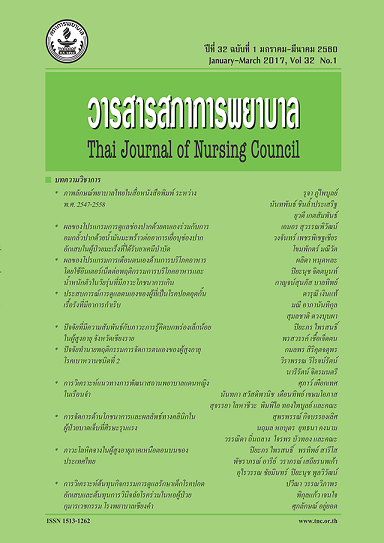ภาวะโลหิตจางในผู้สูงอายุภาคเหนือตอนบนของประเทศไทย;Anaemia in Elderly People in Upper-Northern Thailand
Keywords:
ภาวะโลหิตจาง, ผู้สูงอายุไทย, ภาวะโภชนการ, อาการที่สัมพันธ์กับภาวะโลหิตจาง, anaemia, elderly Thais, nutritional conditions, anaemia-related symptomsAbstract
วัตถุประสงค์: เพื่อศึกษาความชุกของภาวะโลหิตจางในผู้สูงอายุภาคเหนือตอนบนของ
ประเทศไทย อาการที่สัมพันธ์กับภาวะโลหิตจาง และภาวะโภชนาการในผู้สูงอายุที่มีภาวะโลหิตจาง
การออกแบบวิจัย: การวิจัยเชิงพรรณนา
วิธีดำเนินการวิจัย: คัดเลือกกลุ่มตัวอย่างแบบเฉพาะเจาะจง จากผู้ที่มีอายุตั้งแต่ 60 ปี
ขึ้นไป อาศัยอยู่ในเขตภาคเหนือ 4 จังหวัด ได้แก่ เชียงราย เชียงใหม่ พะเยา และลำพูน
จำนวน 477 คน เก็บข้อมูลโดยการสัมภาษณ์และเจาะเลือดส่งตรวจทางห้องปฏิบัติการ
วิเคราะห์ข้อมูล โดยการแจกแจงความถี่ ร้อยละ และค่าเฉลี่ย
ผลการวิจัย: กลุ่มตัวอย่างจำานวน 477 คน มีภาวะโลหิตจางจำนวน 130 คน (ร้อยละ 27.3)
ส่วนใหญ่ เป็นเพศหญิง (ร้อยละ 65.4) โดยเพศหญิงมีภาวะโลหิตจาง (Hb < 12 g/dL)
85 คน คิดเป็นร้อยละ 28.1 เพศชายมีภาวะโลหิตจาง (Hb < 13 g/dL) 45 คน
คิดเป็นร้อยละ 25.7 มีภาวะโลหิตจางจากการขาดธาตุเหล็ก 3 คน คิดเป็นร้อยละ 2.3
มีอาการที่สัมพันธ์กับภาวะซีดภายใน 1 สัปดาห์ที่ผ่านมา 5 อันดับแรก ได้แก่
อาการหลงลืมง่าย คิดช้า คิดไม่ค่อยออก ขาเป็นตะคริว นอนไม่หลับ และรู้สึกไม่คล่องแคล่ว
อาการส่วนใหญ่อยู่ในระดับไม่รุนแรง มีภาวะโภชนาการระดับปกติ ร้อยละ 54.6
และมีความเสี่ยงต่อการเกิดภาวะทุพโภชนาการ ร้อยละ 44.6
ข้อเสนอแนะ: บุคลากรสุขภาพควรตระหนักถึงความสำาคัญของภาวะโลหิตจางในผู้สูงอายุ
มีการประเมินติดตามอย่างต่อเนื่อง รวมถึงเฝ้าระวังอาการที่สัมพันธ์กับภาวะโลหิตจาง
ที่อาจเกิดขึ้น
Objective: To study the prevalence of anaemia amongst elderly people in upper-northern Thailand, anaemia-related symptoms and nutritional conditions in elderly people with anaemia.
Design: Descriptive research.
Procedure: This study was conducted on a purposively sampled population of 477 elderly people aged 60 or higher in 4 upper-northern provinces of Thailand,namely, Chiang Rai, Chiang Mai, Phayao and Lamphun. Data were collected by meansof interviews and through the laboratory analysis of the participants’ blood samples.
The data were analysed in terms of frequency, percentage and mean.
Results: Out of the 477 participants, 302 (63.3%) were female and 175 (36.7%) were male. Nearly one-third of the participants, 130 (27.3%), had been diagnosed with anaemia. Also, almost one-third of the female participants (28.1%) had an average Hb level of Hb < 12 g/dL, whilst about a quarter of the 175 male participants (25.7%)
showed an average Hb level of Hb < 13 g/dL. Of the 130 participants diagnosed with anaemia, only 3 (2.3%) were found with iron defciency. The 5 most detected symptoms accompanying paleness during the week before
the blood-test included absent-mindedness, slow thinking, leg cramps, sleeplessness and lack of agility, although most of these symptoms were not severe. More than half of the participants (54.6%) showed normal nutritional conditions, whilst the remaining 44.6% faced a risk of malnutrition.
Recommendations: Healthcare personnel are advised to pay close attention to anaemia in elderly patients, to perform an on-going follow-up programme and to be on alert for the occurrence of any anaemia-related symptoms.








